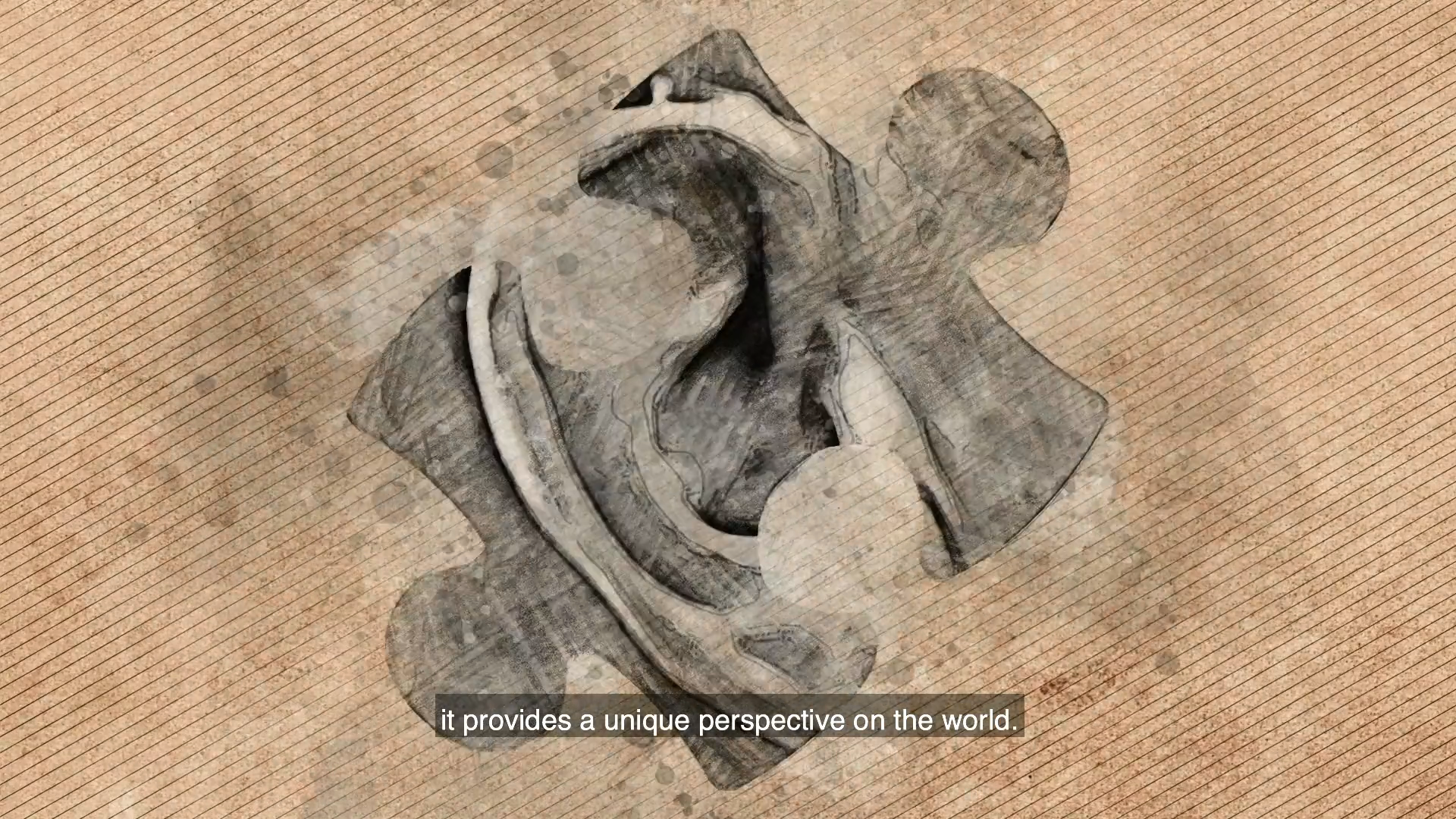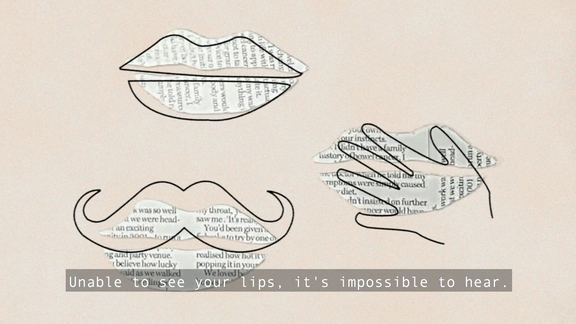Spinning into Silence
Directed by EMILY LARKIN
United Kingdom, 2021
Documentary, Experimental
A personal look at living with Vestibular Disorder.
Read our interview with Emily below to learn more about the film.
EMILY LARKIN
Est. Reading Time: 6 Minutes
MARK (M) Tell us a little about yourself - when did you become interested in film and filmmaking? And what made you particularly interested in animation?
EMILY (E) Like most children, I loved films and cartoons. Apparently the only time I used to focus or sit still for any length of time was when I watched films, it was almost as though they mesmerized me so whilst I can't remember the exact moment I became interested in film and filmmaking, I would like to think it is something that has always been a part of me. Animation specifically grabbed my attention because I loved to draw and doodle so the idea that I was able to make those drawings move blew my mind and even to this day, as a 23 year old, the feeling of making drawings come to life still never gets old.
M Why are you interested in making films?
E My biggest fear is to die without making my impact on the world so being a filmmaker means I am able to attempt to bring change by creating films that mean something to people, to make those who feel invisible heard and understood. So my films can used as tools to help people whether that includes bringing awareness to a condition or topics that other people will find as difficult or challenging to tackle - I love a challenge!
M Your film is really engaging and moving! Please tell us about the importance of immersion in heightening the viewer's perspective and understanding of Vestibular Disorder?
E Thank You! Very little is known about one condition I live with, despite many people having the same or similar types of conditions. I knew raising awareness about Vestibular (inner ear) Disorders should be the topic of my project so I came up with the idea of Spinning into Silence. The result is a 2D hand-drawn experimental animation featuring layered audio and a poem I wrote that communicates my personal experience, as the old adage is true - someone will never truly ‘get it’ until they get it so I wanted to visually represent what an attack feels like for others to experience.
I wanted to show what life is like for people living with these conditions - whilst they affect everyone differently, the most common symptoms are hearing loss, dizziness/vertigo and balance problems. Audibly, I wanted the viewer to really experience what it’s like to have hearing loss and tinnitus (ringing/buzzing in the ears). The film truly mimics what I hear all the time, during and after a vestibular ‘attack’. For example, there’s a constant underwater-type sound throughout the film because my ear hears lower frequencies better, so everyone sounds like they’re underwater when talking to me.
On Visual Style
M I really like your visual style - it imbues a lot of empathy and feeling. How does your tactile and textured aesthetic complements the mood and themes of the film?
E I like traditional styles and methods of animation, specifically hand-drawn but my last two years of university were during the pandemic so digitally drawing my animation was easier however I wanted to keep the textures and layered style most of my work has so I didn't think this film should be any different. I needed to keep the visuals simple so that the audience is able to process the audio and the visuals at the same time. If it were too busy visually, the audience would have been forced to choose between focusing on one area or the other. This particular visual style took a lot of work with 182 hand-drawn layers per frame, which means at a little over three mins with 24 frames per second, the total number of layers was around 786,240, not including the experiments that didn't make the cut! There are also some visual 'easter eggs’ – every sixth ear in the last scene has a hearing aid, reflecting the fact that 1 in 6 people have some level of hearing loss, while the mouths in the lipreading scene say ‘can you read my lips?’. Oh and there's a Zebra on the carousel!
On Colour Design
M It's interesting to see lots of brown, black and grey colours on screen. Please tell us a little about your approach to the film’s colour design - how much time did you spend experimenting with different shades and tones of colour?
E My previous film Who’s Not Listening? (2020) (WNL) had a similar design with simple lighter beige and brown colours as well as a little bit of black to kind of offset those colours. I believe it worked well so I wanted to see how I could push and twist it for this film. I decided I didn't like the pinkish beige colour of WNL and wanted more of an old newspaper and cardboard brown colour so I just kept tweaking and testing numerous colours until I found a range that I liked.
‘Audibly, I wanted the viewer to really experience what it’s like to have hearing loss and tinnitus. The film truly mimics what I hear all the time’
— Emily Larkin
On Process & Discovery
M In making and finishing the film, what did you discover and learn that you might adopt or further explore in future projects?
E This film was created as part of my final project for my degree, it’s my graduation film so numerous things were learned, mainly that dinner can be eaten in no time at all if I have a deadline looming but other things too. For example, I think I need to learn better pacing of my spoken word poetry as at points in this film, the words don't hit just right so that was something that I explored further before making my next film. I would like to think the pacing is better in my latest film released last month.
On Inspiration
M What are some of the films and who are some of the filmmakers that inspire you, and why?
E I just love films, films of any kind, I've learnt that I will sit through pretty much everything but I particularly love older films (don't want to make anyone feel old) with my favourite film being Back to the Future (1985). I just love the texture of older films, seeing how much work and effort went into films back then before technology was advanced as it is today. I wouldn't go as far to say that filmmakers these days have it easier, they certainly don't, just that film then required more imagination and problem solving which to me is beautiful. My friends and fellow filmmakers that I have worked with throughout university inspire me, I love how everyone approaches things differently and I think that is something film and filmmaking highlights beautifully.
Back to the Future (1985) by Robert Zemeckis
On The Future
M I know your goals might change and grow over time, but what are your current goals in filmmaking?
E I recently released my latest film Tainted Memories (2022) which aims to break the cycle of child abuse. So I don’t have any new projects in development at the moment. I am focusing on my portfolio and showreel in an attempt to get out of my retail job into a job I love, which would help me work on filmmaking full-time and aim to change the world one short film at a time.
Tainted Memories (2022) by Emily Larkin
Tainted Memories (2022) by Emily Larkin
Mark’s Final Thoughts
Emily succeeds in pulling viewers into the everyday reality of her interactions with people and the world around her. The sequence of sound building and drowning out her narration is really effective and moving in portraying her experience. I appreciate the fact that Emily does not hold back or lessen the fullness of her experience - she’s blunt, honest and sincere.
It's great that Emily can look at her work objectively and identify specific areas of improvement. I understand that she may feel the pacing is slightly uneven at times however I think her relatively quick narration style matches the film’s immersive and unsettled atmosphere.
And it’s fantastic to see the evolution and progression of her visual style - as shown in our comparison images, the visuals in this film are more detailed, textured and distinctive than WNL. Emily pushes the boundaries of her style in Tainted Memories through creating an illusive painterly look on screen.
The founder of Hommage, Mark Shaba published this interview on 24.05.2022. Mark is a filmmaker from Victoria, Australia. He respectfully acknowledges the past and present traditional owners of the land on which he creates, promotes and screens art, the Wurundjeri people of the Kulin nation who are the custodians.


























